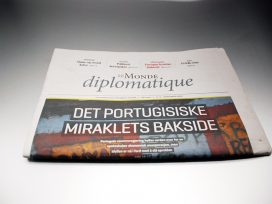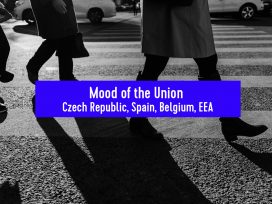United 93 -- "Let's Roll!"
There are several reasons to believe that United Airlines flight 93 was shot down by an American fighter plane. Why are the American authorities being so secretive?
10.03 am on the 11th of September 2001. The fourth plane hijacking. The crash landing in Pennsylvania. Now in the guise of docufiction about a terrorist act:
In the film United 93, (currently playing at a cinema near you) a dozen Americans struggle up the aisle of the hijacked airliner. Their lives hanging in the balance, they decide to overpower the four hijackers with kicks and punches and the use of cutlery implements as weapons. The suicide bomb around the Arab’s waist was probably a fake one, or else he had not managed to detonate it before being taken down by his assailants. The passengers then throw themselves against the door to the cockpit, where a terrorist sits at the controls. These panic-stricken passengers are unaccustomed to fighting; clumsy punches from desperate and terrified people fearing for their lives. And they manage it – after a violent struggle up front amongst the flight instruments in the cockpit. The plane hurtles down towards the ground; the everyday heroes in the cockpit do not manage to straighten out the nose of the plane before it hits the ground.
Directed by Paul Greengrass, this American-produced film is compelling and somewhat critical of the levels of preparedness displayed by the Federal Aviation Authority and the military – but not critical enough. Unlike such independent film-makers as those who brought us Paradise Now or Good Night, and Good Luck,1 this is much more of a Hollywood movie.
Even so, how many people are being left after seeing United 93 with a conscious perception of “what really happened”? Or terrifying images of “the enemy” embodied by tense and sweaty Arab terrorists?
The film is based on the official American line – that the plane crashed as a result of a revolt against the terrorists. But now, five years after September 11th, there are just too many disturbing details surrounding the events (Le Monde diplomatique (Oslo) 7, 8, 9/2006)2). There is therefore a high level of involvement from those still capable of questioning the way things are. Evidently there are a number of theories concerning 9/11 that just don’t add up (see also “Digital Misinformation”3, but we must be able to talk openly about this without being summarily dismissed as conspiracy theorists. There remains a great deal we would like to know more about.
Asking questions is “the piety of thought”, as the German philosopher Martin Heidegger once said. Now I’m not really all that pious, but my anarchistic tendencies are roused by the secrecy of the authorities, by feeble excuses and people who try to keep our fingers out of the pie.
So what really happened on United flight 93? There are in fact several reasons to believe that United Airlines flight 93 was shot down by an American fighter plane to prevent it striking the White House or the Capitol in Washington DC. And that the American authorities, fearing criticism, have taken the political decision to keep this under wraps. Just think of the consequences if the Americans themselves had caused the deaths of 40 of their own citizens? What if they had not been attacked from the outside? September 11th would not then have been the same “useful” terror cover story for everything the Bush Administration has since been able to justify.
Rowland Morgan’s new book, Flight 93: What Really Happened on the Heroic 9/11 “Let’s Roll” Flight,4 released on 24 August, now paints a different picture from the official American explanation: In all probability, the airliner was shot down. (Both the film and the official explanation maintain that the military fighter planes did not manage to come any closer than 20 kilometres to the airliner). But Jim Brant, who was working near one of the lakes where plane wreckage was found, reported hearing the sound of a fighter jet overhead – then saw flames leaping into the air. When he looked up he saw a white plane circling over the crash site: “It reminded me of a fighter jet,” he said. Twelve eyewitnesses said that they actually saw fighter jets at the same time. Several reported seeing “a white fighter plane” circle around the airliner both before and after the crash. Others said that they saw an F-16 approach and fire what are thought to have been two Sidewinder missiles, one of them hitting one of the engines, after which the plane “dropped all of a sudden, like a stone.” One eyewitness also said that the FBI refused to take her statement, claiming there were no such planes in the area.
Very little debris from the huge engines was found at the supposed crash site. Fighter planes may have fired a heat-seeking missile – the sound of which was recognised by a Vietnam-veteran among the witnesses – which could have splintered a jet engine and caused the plane to crash.
The timing of the crash also raises suspicions. The authorities, the FBI, and the 9/11 Commission reported that the plane hit the ground at 10.03 am, based on data from the airliner’s black box recording – the same crash time is also reproduced in the credits of the film United 93. But four (yes, four!) seismological stations in the surrounding area reported the time as 10.06 am (with an accuracy rating of plus/minus 2 seconds). So there are two crash times… but why is there such secrecy surrounding the plane’s black box recording? It has never been released to the public and may therefore have been tampered with. So what could have happened in those last three minutes? Under heavy security, in a hotel in April of 2002, and after several years of having to put constant pressure on the authorities, bereaved relatives were finally able to hear the sound recording from the plane’s black box: they recount how they heard a fight taking place onboard the plane at 9.58 am, and then a “rushing sound” at 10.03 am. As Morgan points out, the sound could be gusts of air subsequent to the plane being hit and punctured.
The explanations of the American authorities vary; information is suspiciously withheld from us.
The revolt against the terrorists on flight 93 was quickly exploited in 2001: most notably, passenger Todd Beamer’s telephone conversation with a telephone switchboard operator on the ground. The 15-minute long conversation ended with the words “Let’s Roll!” just before the passengers stormed up the aisle. To all intents and purposes, the expression became a slogan for Bush’s “War on Terror” As early as 20 September, Bush, with Beamer’s widow at his side, declared a “defining moment in American history”. Shortly afterwards came the Iraq war and the speech: “We have our marching orders: My fellow Americans, let’s roll.” And what about the crew of a warship en route to Iraq, who stood on deck in a formation that spelled out the words “Let’s Roll”? Not only was the widow photographed next to a fighter plane, the side of which was emblazoned with the words “Let’s Roll!”, she also came out with a book bearing the self-same title on a patriotic cover of Stars and Stripes. In addition to the seven-figure compensation sum she received from the authorities, the book conferred a six-figure contract.
And then there is the conversation with Beamer. Telephone switchboard operator Lisa Jefferson wrote a bestselling book entitled Called – relating how her life was transformed by Todd Beamer’s call. It may be worthwhile noting that Ms Jefferson worked at Verizon Corp., a company with a contract worth 750 million dollars to install a high-security telecommunications system across American government departments. Moreover, she did not follow normal procedure whereby all emergency calls are recorded, neither did she transfer the call to Beamer’s wife – his wife was not even informed of the phone call, something the operator had allegedly promised to do. According to Jefferson, Beamer “called on God” and quoted from the Bible together with Ms Jefferson – something which baffled his wife. So had it really been Beamer the operator had spoken to?
The crash site near Shanksville, Pennsylvania, contained too little wreckage: are we to believe that a Boeing 757, measuring 155 feet, plus two engines each weighing 6 tonnes, would simply disappear 10 meters into the earth as is claimed to have happened? What about the plane section the size of a dining room table which was found in a lake 3-4 kilometres away? Or the metal fragments discovered up to 15 kilometres away? The FBI claimed that these fragments could have been swept there by the wind – even though there was only a light wind.
The only trace the FBI purportedly found of the passengers when the plane compressed itself into the earth was a passport belonging to one of the terrorists and a red bandana – we see the hijackers wearing similar headgear in the film United 93.
It is possible that Morgan is right: “I believe that Flight 93 may well have been deliberately shot down as a means of stopping it from reaching its ultimate target. […] It is a suspicion that was held even by the FBI, but was swept aside as a shaken America clung on to the official version of selfless sacrifice and raw patriotism.”
Neither can one exclude the possibility that a bomb was detonated, but usually this would have produced a 20-mile long trail of plane wreckage, as was the case in the Lockerbie crash. The question is what was really concealed in the last three minutes of the black box recording. Has it struck you that the passengers really could have overpowered the terrorists? Could it be that with the pilot from among the passengers is finally at the controls, the plane lurches to avoid being shot at and then straightens out? At that very moment, the plane could have become an easy target for the military fighter plane’s missiles. Could it be that somewhere, concealed in the recording, are the celebratory sounds of victory in the seconds before the missiles struck?
Such a blunder could never have justified the Bush Administration’s subsequent rolling out of the big guns.
Respectively, a film about Palestinian suicide bombers and the Communist witch-hunt in America. See Warner Independent Pictures, wip.warnerbros.com.
In July, August, and September, Le Monde diplomatique (Oslo) focused on the US's official explanation of 9/11. This sparked enormous interest worldwide and the articles have now been reproduced online in French and other languages, translated by the Internet community. The articles have also been published on websites such as http://911blogger.com and www.911Truth.org. Articles in other Norwegian newspapers and online editions also followed.
Le Monde diplomatique (Oslo) 9/2006, p. 8.
Published on 24 August by Constable & Robinson, US. The main points of the book are also reproduced in an abridged version by Morgan in the newspaper the Daily Mail. See www.dailymail.co.uk.
Published 13 October 2006
Original in Norwegian
Translated by
Nicole M. Fishlock
First published by Le Monde diplomatique (Oslo) 9/2006 (Norwegian version)
Contributed by Le Monde diplomatique (Oslo) © Truls Lie/Le Monde diplomatique (Oslo) Eurozine
PDF/PRINTNewsletter
Subscribe to know what’s worth thinking about.



